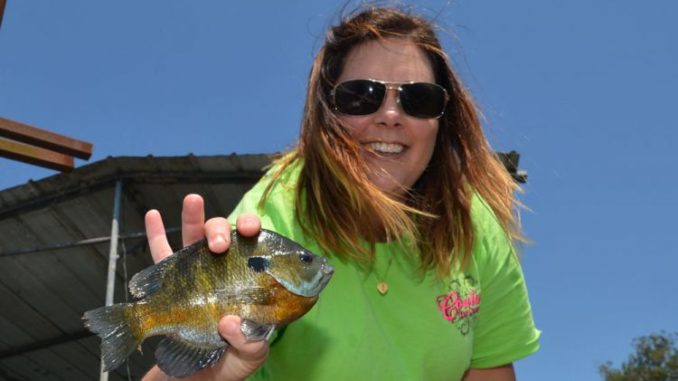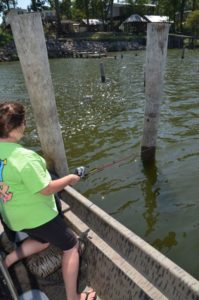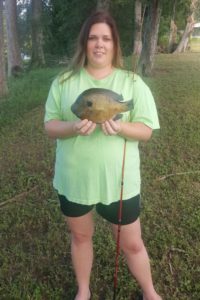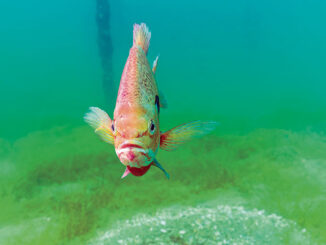
This Old River bream specialist placed her first bluegill in the state’s record books last fall — now she shares a few tips on how to ‘run with the bulls.’
It was September.
It was hot, and it was late in the day.
Bream season was long over with in most places in Louisiana — but not on Old River.

The youngish couple was picking and poking their way among the derelict pier pilings on the levee side of the big oxbow lake. Gene Francois, standing on the bow and jockeying the trolling motor, was intense. His focus was on crappie, mostly called sac-a-lait here in Cajun Pointe Coupee Parish.
His wife Padra, at first glance, appeared to be laid back. She was fishing with a simple Zebco 33 spincast reel on a 5-foot Slingshot rod. She was dunking a cricket, mostly straight down.
They called it combo fishing: He was chasing one thing, and she was chasing another.
But looks can be deceiving —Padra was a serious bream specialist.
She was catching bull bream one after the other, but wound up battling a pretty special fish that day.
The bite from the big one came like any bream bite, but the giant fish fought sluggishly. Later she thought that maybe it was just old and it was its time to be caught.
When the beast came up, Gene immediately began hollering and jumped to get the landing net. He knew it was a recordbook fish.
The 1-pound, 6-ounce monster was so big it looked deformed. Its steep forehead was creased crossways, giving it a hump-headed appearance. Its body was so thick and bulky that it looked stuffed, and ultimately it placed seventh in Louisiana’s all-time record book.
Specialist might be a mild word to describe Padra, but fanatic might be more appropriate.
From their camp perched on stilts 18 feet above a high bank on the levee side of the lake, the couple have pursued bream and sac-a-lait since 2004. Normally in September, they would stick to fishing pilings, piers and rafts on the levee side of the lake, but on our 2017 trip, the water was high enough to pound the cypress trees on the lake’s other side.
Both of them kept their baits tight to the tree trunks. Although Padra admitted to sometimes using a sliding cork, both were tight-lining, an approach effective in fishing the deep waters they often target.
Gene’s 10-foot jig pole was outfitted with an ultralight spinning reel. Padra’s rationale for favoring a spincast reel was simple: “Other reels get backlashes and everybody gets frustrated. This is easy and it works,” she said. “I don’t think fish have a preference for any certain reel.”
Point made.
The water in the cypress trees was 4 to 6 feet deep. With the boat close enough to reach a tree with her short rod, she gently dropped her cricket-baited hook to the bottom, picked it up 6 to 12 inches and gently moved it to attract a bream’s attention. By not allowing the bait to touch bottom she maintained constant contact with it.
Old River habitat
In the best of times, bull bream bite not by charging off with a baited hook, but rather by grabbing it and holding it. On this day, immediately after a powerful September cold front, the bites were even less aggressive — more like gentle taps than hits.

She fished with deep concentration and a subtle touch, seldom missing a fish. And she caught more than bream, including catfish, gaspergou and even a cricket-eating sac-a-lait.
Although the catch was steady, the duo moved their boat to fish around rafts anchored off Alligator Point on the north side of the lake. (See the accompanying sidebar on Old River rafts, and raft courtesy.) She probed through every gap and opening in the raft and was rewarded by finding a school of bream suspended in the raft’s shade 5 feet deep in 12 feet of water.
They eventually left to show off the final type of habitat they fish in the big oxbow lake, the piers and derelict pier pilings set in deep water off the levee (south) side of the lake. There were literally thousands of them.
The fishing structure was impressive — the uncountable number of pilings, the dense concentration of rafts as well as the innumerable flooded cypress trees: There was no shortage of places to hold fish.
With fish to clean, Padra and Gene headed back to the camp. As the boat chugged homeward, she volunteered that she didn’t like to eat catfish and that bream taste better than sac-a-lait.
Gene quickly countered.
“The only way a bream could be better than a sac-a-lait is if they could turn into a sac-a-lait,” he quipped.
“That’s bull,” she parried back, with abrupt finality.
